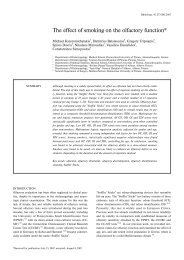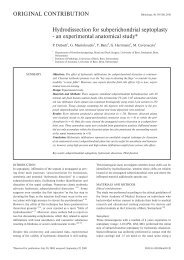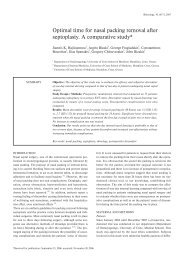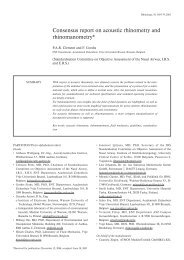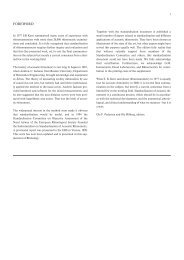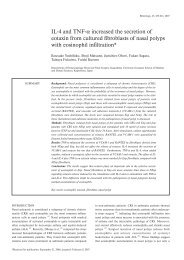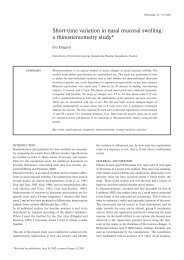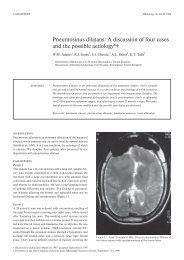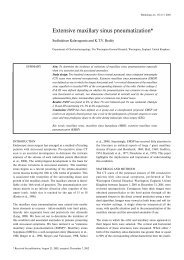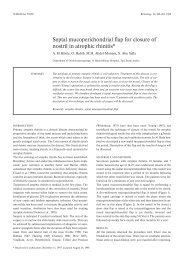The role of ethmoid sinus surgery in the - Rhinology Internation ...
The role of ethmoid sinus surgery in the - Rhinology Internation ...
The role of ethmoid sinus surgery in the - Rhinology Internation ...
You also want an ePaper? Increase the reach of your titles
YUMPU automatically turns print PDFs into web optimized ePapers that Google loves.
Rh<strong>in</strong>ology, 36, 20–23, 1998<br />
<strong>The</strong> <strong>role</strong> <strong>of</strong> <strong>ethmoid</strong> <strong>s<strong>in</strong>us</strong> <strong>surgery</strong> <strong>in</strong> <strong>the</strong><br />
treatment <strong>of</strong> <strong>the</strong> twisted nose*<br />
Y. Ducic 1 , P.A. Hilger 2<br />
1<br />
2<br />
Division <strong>of</strong> Otolaryngology and Facial Plastic Surgery, John Peter Smith Hospital, Fort Worth, U.S.A.<br />
Division <strong>of</strong> Facial Plastic and Reconstructive Surgery, Department <strong>of</strong> Otolaryngology,<br />
University <strong>of</strong> M<strong>in</strong>nesota, U.S.A.<br />
SUMMARY<br />
<strong>The</strong> correction <strong>of</strong> <strong>the</strong> twisted nose rema<strong>in</strong>s a challenge from both <strong>the</strong> functional and aes<strong>the</strong>tic<br />
po<strong>in</strong>ts <strong>of</strong> view. It is well recognized that complete correction <strong>of</strong> this nasal deformity <strong>of</strong>ten necessitates<br />
not only reconfiguration <strong>of</strong> <strong>the</strong> external nasal framework, but also realignment <strong>of</strong> <strong>the</strong><br />
septum. <strong>The</strong> occasional patient will, <strong>in</strong> addition, require concurrent middle turb<strong>in</strong>ate resection<br />
and/or <strong>ethmoid</strong>ectomy to enable one to achieve full correction <strong>of</strong> both his/her external and<br />
septal deformities. We will briefly outl<strong>in</strong>e <strong>the</strong> rationale for this approach with an illustrative<br />
case example.<br />
Key words: <strong>ethmoid</strong>, <strong>s<strong>in</strong>us</strong>, twisted nose, nasal deviation, <strong>surgery</strong><br />
INTRODUCTION<br />
Rh<strong>in</strong>oplasty cont<strong>in</strong>ues to rema<strong>in</strong> one <strong>of</strong> <strong>the</strong> most challeng<strong>in</strong>g <strong>of</strong><br />
surgical procedures. To obta<strong>in</strong> consistently reward<strong>in</strong>g results,<br />
from both an aes<strong>the</strong>tic and a functional po<strong>in</strong>t <strong>of</strong> view, one must<br />
critically analyze <strong>the</strong> unique spectrum <strong>of</strong> deformities present <strong>in</strong><br />
<strong>the</strong> <strong>in</strong>dividual patient. Vigilant analysis <strong>of</strong> <strong>the</strong> nasal framework<br />
is <strong>of</strong> <strong>the</strong> utmost importance <strong>in</strong> all nasal <strong>surgery</strong>, and, <strong>in</strong> particular,<br />
<strong>in</strong> <strong>surgery</strong> <strong>of</strong> <strong>the</strong> so-called “twisted nose” (Planas, 1977;<br />
Courtiss, 1978; Lawson, 1978; McK<strong>in</strong>ney and Shiveley, 1979;<br />
Stucker, 1982; Constantian, 1989). <strong>The</strong> twisted nose, <strong>in</strong> fact,<br />
represents a common aes<strong>the</strong>tic endpo<strong>in</strong>t aris<strong>in</strong>g from a plethora<br />
<strong>of</strong> possible underly<strong>in</strong>g structural problems.<br />
<strong>The</strong> ideal nasal contour is represented by a smooth symmetrical<br />
l<strong>in</strong>e curv<strong>in</strong>g from <strong>the</strong> medial brow, along <strong>the</strong> dorsum and <strong>in</strong>to<br />
<strong>the</strong> area <strong>of</strong> <strong>the</strong> tip-def<strong>in</strong><strong>in</strong>g po<strong>in</strong>t. Even a m<strong>in</strong>or deflection <strong>of</strong><br />
this contour l<strong>in</strong>e, ei<strong>the</strong>r medially <strong>of</strong> laterally, will impart an<br />
apparent curvature <strong>of</strong> <strong>the</strong> external nasal framework, giv<strong>in</strong>g rise<br />
to <strong>the</strong> twisted nose.<br />
<strong>The</strong> nasal framework is essentially a tripod configuration, consist<strong>in</strong>g<br />
<strong>of</strong> <strong>the</strong> nasal bones <strong>in</strong> <strong>the</strong> upper one-third and <strong>the</strong> upper<br />
and lower lateral cartilages <strong>in</strong> <strong>the</strong> lower two-thirds. Both <strong>the</strong><br />
bony and cartilag<strong>in</strong>ous dorsum rest on <strong>the</strong> middle limb <strong>of</strong> <strong>the</strong><br />
tripod, <strong>the</strong> nasal septum. <strong>The</strong> old adage “as goes <strong>the</strong> septum, so<br />
goes <strong>the</strong> nose” arises from <strong>the</strong> notion that significant long-term<br />
deviation <strong>of</strong> <strong>the</strong> septum will lead to, or be associated with, an<br />
external nasal deformity. This is especially true with short nasal<br />
bones. This is <strong>in</strong>tuitively obvious if one recalls <strong>the</strong> firm attachments<br />
<strong>of</strong> both <strong>the</strong> external nasal cartilages and nasal bones to<br />
<strong>the</strong> dorsal septum. If <strong>the</strong> septum is deflected, <strong>the</strong> external<br />
framework will, <strong>of</strong> necessity, be pulled along for <strong>the</strong> ride. If a<br />
twisted nose is a result <strong>of</strong> recent trauma, realignment <strong>of</strong> both<br />
<strong>the</strong> dorsum and <strong>the</strong> septum to <strong>the</strong>ir premorbid status can <strong>of</strong>ten<br />
be accomplished <strong>in</strong> a closed manner without significant<br />
difficulty and with an <strong>of</strong>ten reward<strong>in</strong>g result. Occasionally, full<br />
restitution <strong>of</strong> septal form follow<strong>in</strong>g acute trauma may require an<br />
open septoplasty approach. Long-stand<strong>in</strong>g deformities may<br />
result <strong>in</strong> an activation <strong>of</strong> chondrocytes <strong>in</strong> <strong>the</strong> deflected septum,<br />
giv<strong>in</strong>g rise to septal spurs, duplications and cartilag<strong>in</strong>ous excess<br />
that will have to be surgically addressed. Scar maturation with<strong>in</strong><br />
<strong>the</strong> s<strong>of</strong>t-tissue envelope and remodell<strong>in</strong>g <strong>of</strong> <strong>the</strong> osseo-cartilag<strong>in</strong>ous<br />
framework will <strong>of</strong>ten lead to long-term mold<strong>in</strong>g <strong>of</strong> <strong>the</strong><br />
nasal bones. This may give rise to a discrepancy <strong>in</strong> <strong>the</strong> height <strong>of</strong><br />
<strong>the</strong> two nasal bones, with <strong>the</strong> nasal bone on <strong>the</strong> convex side<br />
usually longer than its counterpart on <strong>the</strong> concave side. This difference<br />
<strong>in</strong> height may be addressed by excis<strong>in</strong>g more <strong>of</strong> <strong>the</strong><br />
nasal bone on <strong>the</strong> convex side dur<strong>in</strong>g lower<strong>in</strong>g <strong>of</strong> <strong>the</strong> nasal dorsum,<br />
prior to osteotomies (Toriumi and Ries, 1993). When<br />
<strong>the</strong>re is an adequate nasal airway and <strong>the</strong> deviation from <strong>the</strong><br />
ideal contour l<strong>in</strong>e is not major, simple camouflage techniques<br />
will <strong>of</strong>ten suffice <strong>in</strong> provid<strong>in</strong>g an aes<strong>the</strong>tically acceptable result.<br />
One may camouflage a deformity with <strong>the</strong> use <strong>of</strong> only grafts <strong>of</strong><br />
bone, cartilage or syn<strong>the</strong>tic material. Occasionally, spreader<br />
grafts may be utilized <strong>in</strong> <strong>the</strong> correction <strong>of</strong> twist<strong>in</strong>g <strong>of</strong> <strong>the</strong> middle<br />
one-third <strong>of</strong> <strong>the</strong> nose, serv<strong>in</strong>g to both address cosmetic realign-<br />
* Received for publication February 17, 1997; accepted July 10, 1997
Twisted nose <strong>surgery</strong> 21<br />
ment concerns, as well as functional needs at <strong>the</strong> level <strong>of</strong> <strong>the</strong><br />
nasal valve (Sheen, 1984).<br />
Well recognized is <strong>the</strong> fact that if <strong>the</strong>re is co-existent significant<br />
deviation <strong>of</strong> <strong>the</strong> nasal septum and <strong>the</strong> nasal framework, it is<br />
<strong>of</strong>ten not possible to correct a functional breath<strong>in</strong>g problem by<br />
only br<strong>in</strong>g<strong>in</strong>g <strong>the</strong> septum to an anatomically-correct midl<strong>in</strong>e<br />
position. In fact, this may paradoxically serve to obstruct <strong>the</strong><br />
patient's airway even fur<strong>the</strong>r, as <strong>the</strong> septum now abuts <strong>the</strong> <strong>in</strong>tranasal<br />
aspect <strong>of</strong> <strong>the</strong> external nasal concavity and, hence, closes<br />
<strong>the</strong> airway. <strong>The</strong>refore, realignment <strong>of</strong> <strong>the</strong> external nasal framework<br />
to an anatomically more normal position is required to<br />
alleviate this problem, and establish an adequate nasal airway<br />
bilaterally after septoplasty. Similarly, <strong>the</strong> converse holds true.<br />
Occasionally, one is unable to treat <strong>the</strong> aes<strong>the</strong>tic concerns a<br />
patient may have with respect to significant twist<strong>in</strong>g <strong>of</strong> <strong>the</strong><br />
external nasal framework without concurrently address<strong>in</strong>g <strong>the</strong><br />
underly<strong>in</strong>g septal pathology. A major uncorrected deviation <strong>of</strong><br />
<strong>the</strong> septum, besides <strong>of</strong>ten be<strong>in</strong>g <strong>of</strong> functional importance, may<br />
not allow <strong>the</strong> surgeon to satisfactorily realign <strong>the</strong> external nasal<br />
contour. Fur<strong>the</strong>rmore, surgically medializ<strong>in</strong>g <strong>the</strong> nasal bones<br />
and upper lateral cartilages aga<strong>in</strong>st a deviated septum will <strong>in</strong>evitable<br />
compromise <strong>the</strong> patient’s nasal airway. Thus, <strong>the</strong> rh<strong>in</strong>oplasty<br />
surgeon <strong>of</strong>ten needs to address both <strong>the</strong> septum and <strong>the</strong><br />
external nose to fully correct <strong>the</strong> patient’s aes<strong>the</strong>tic and functional<br />
concerns.<br />
<strong>The</strong> nasal septum, <strong>of</strong> course, does not exist <strong>in</strong> isolation with<strong>in</strong><br />
<strong>the</strong> nasal vault. It shares this limited space with <strong>the</strong> nasal turb<strong>in</strong>ates<br />
and <strong>the</strong> <strong>ethmoid</strong> system <strong>of</strong> air cells. In <strong>the</strong> majority <strong>of</strong><br />
patients, one can achieve adequate anatomical restitution <strong>of</strong><br />
both septal and external nasal framework positions without specifically<br />
surgically correct<strong>in</strong>g <strong>the</strong> turb<strong>in</strong>ates and <strong>ethmoid</strong> <strong>s<strong>in</strong>us</strong>.<br />
However, <strong>in</strong> some patients, adequate correction <strong>of</strong> <strong>the</strong> twisted<br />
nose can only be accomplished if enough room is made <strong>in</strong>tranasally<br />
to allow for reposition<strong>in</strong>g <strong>of</strong> <strong>the</strong> septum and <strong>the</strong> nasal<br />
bones. Most <strong>of</strong>ten, one is deal<strong>in</strong>g with a grossly enlarged middle<br />
turb<strong>in</strong>ate or a concha bullosa (aeration <strong>of</strong> <strong>the</strong> middle turb<strong>in</strong>ate)<br />
that seems to expand <strong>in</strong>to <strong>the</strong> concavity <strong>of</strong> <strong>the</strong> septum. An<br />
enlarged, obstruct<strong>in</strong>g concha bullosa is generally <strong>of</strong> no functional<br />
significance <strong>of</strong> itself, but will need to be ei<strong>the</strong>r resected or<br />
o<strong>the</strong>rwise reduced <strong>in</strong> size (e.g. <strong>in</strong>-fractur<strong>in</strong>g). We prefer to partially<br />
resect <strong>the</strong> obstruct<strong>in</strong>g middle turb<strong>in</strong>ate and, thus, preserve<br />
a valuable landmark for any future endoscopic nasal <strong>surgery</strong><br />
that <strong>the</strong> patient may require. Out-fracture <strong>of</strong> <strong>the</strong> middle turb<strong>in</strong>ate<br />
may compromise <strong>the</strong> ostiomeatal complex. Fur<strong>the</strong>rmore,<br />
<strong>the</strong> cribriform plate attachment <strong>of</strong> <strong>the</strong> middle turb<strong>in</strong>ate may be<br />
disrupted, lead<strong>in</strong>g to CFS leaks, dural tears, et cetera.<br />
Occasionally, <strong>the</strong> <strong>ethmoid</strong> air cell system fills <strong>the</strong> concavity <strong>of</strong><br />
<strong>the</strong> twisted septum. Adequate movement <strong>of</strong> both <strong>the</strong> nasal<br />
bones and <strong>the</strong> septum to <strong>the</strong> midl<strong>in</strong>e is really not possible <strong>in</strong><br />
such a circumstance without first complet<strong>in</strong>g an <strong>in</strong>tranasal partial<br />
or total <strong>ethmoid</strong>ectomy, which allows <strong>the</strong> middle turb<strong>in</strong>ate<br />
to move laterally, permitt<strong>in</strong>g <strong>the</strong> septum to rest <strong>in</strong> <strong>the</strong> midl<strong>in</strong>e.<br />
Only at this po<strong>in</strong>t, will <strong>the</strong>re be enough <strong>of</strong> a void created to<br />
allow for this correction. Deformities or hypertrophy <strong>of</strong> <strong>the</strong> <strong>in</strong>ferior<br />
turb<strong>in</strong>ate have <strong>of</strong>ten been associated with septal deformities.<br />
<strong>The</strong> necessity <strong>of</strong> address<strong>in</strong>g such <strong>in</strong>ferior turb<strong>in</strong>ate problems<br />
when correct<strong>in</strong>g <strong>the</strong> septum, has been well established.<br />
Although far less common, deformities with<strong>in</strong> <strong>the</strong> middle turb<strong>in</strong>ate<br />
or <strong>ethmoid</strong> <strong>s<strong>in</strong>us</strong>es should be addressed utiliz<strong>in</strong>g <strong>the</strong>se<br />
same pr<strong>in</strong>ciples.<br />
<strong>The</strong> need for <strong>ethmoid</strong> <strong>s<strong>in</strong>us</strong> <strong>surgery</strong> will, <strong>of</strong> necessity, have to be<br />
assessed pre-operatively. A thorough <strong>in</strong>tranasal exam<strong>in</strong>ation is<br />
<strong>of</strong> utmost importance <strong>in</strong> <strong>the</strong> patient with <strong>the</strong> twisted nose. An<br />
enlarged, obstruct<strong>in</strong>g concha bullosa can be easily visualized<br />
(and palpated after tropical anaes<strong>the</strong>sia) with a nasal speculum.<br />
Decongestion <strong>of</strong> <strong>the</strong> nasal vault is usually needed to allow clear<br />
visualisation <strong>of</strong> <strong>the</strong> anterior and superior extent <strong>of</strong> <strong>the</strong> <strong>ethmoid</strong><br />
<strong>s<strong>in</strong>us</strong> air cell system. Nasal endoscopy may also be required to<br />
help determ<strong>in</strong>e whe<strong>the</strong>r an <strong>ethmoid</strong>ectomy is necessary to perform<br />
at <strong>the</strong> time <strong>of</strong> corrective nasal <strong>surgery</strong> (Messerkl<strong>in</strong>ger,<br />
1978). If <strong>the</strong> need for <strong>ethmoid</strong>ectomy appears to be present, a<br />
coronal CT scan <strong>of</strong> <strong>the</strong> <strong>s<strong>in</strong>us</strong>es may help <strong>in</strong> clearly visualis<strong>in</strong>g<br />
<strong>the</strong> problem at hand as well as serv<strong>in</strong>g as a useful guide to surgical<br />
correction. Intranasal <strong>ethmoid</strong>ectomy – whe<strong>the</strong>r performed<br />
under direct vision or with <strong>the</strong> use <strong>of</strong> an endoscope – is a<br />
simple procedure, with few complications if performed by an<br />
experienced <strong>s<strong>in</strong>us</strong> surgeon follow<strong>in</strong>g well-established anatomical<br />
landmarks (Wigand et al., 1978; Kennedy et al., 1987;<br />
Stankiewicz, 1989).<br />
<strong>The</strong> follow<strong>in</strong>g case example will be used to demonstrate some<br />
<strong>of</strong> <strong>the</strong> typical f<strong>in</strong>d<strong>in</strong>gs <strong>in</strong> this subset <strong>of</strong> patients with <strong>the</strong> twisted<br />
nose.<br />
CASE REPORT<br />
K.D. is an o<strong>the</strong>rwise healthy 17-year-old male who presented to<br />
our <strong>of</strong>fice for aes<strong>the</strong>tic correction <strong>of</strong> his external nasal deformity.<br />
Upon physical exam<strong>in</strong>ation, he was noted to have a classically<br />
twisted nose, with significant asymmetry and malalignment<br />
<strong>of</strong> <strong>the</strong> nasal bones and upper and lower lateral cartilages<br />
(Figure 1). On three-quarter view, one notes an excessively<br />
generous nasal dorsum as well as microgenia (Figure 2).<br />
Intranasal exam<strong>in</strong>ation revealed caudal septal deflection <strong>in</strong>to<br />
<strong>the</strong> right nasal airway. This defection cont<strong>in</strong>ued posteriorly and<br />
was associated with both reduplication <strong>of</strong> <strong>the</strong> septum as well as<br />
<strong>the</strong> presence <strong>of</strong> some septal spurs. After nasal decongestion<br />
with topical oxymetazol<strong>in</strong>e spray, one could visualize <strong>the</strong> <strong>ethmoid</strong><br />
air cell system imp<strong>in</strong>g<strong>in</strong>g on <strong>the</strong> septal concavity high on<br />
<strong>the</strong> patient’s right side. Inability to clearly visualize <strong>the</strong> left side<br />
and <strong>the</strong> desire to have more preoperative <strong>in</strong>formation <strong>in</strong> handl<strong>in</strong>g<br />
this complex problem, led us to obta<strong>in</strong> a coronal CT-scan <strong>of</strong><br />
<strong>the</strong> <strong>s<strong>in</strong>us</strong>es (Figure 3). <strong>The</strong> patient had no radiological evidence<br />
<strong>of</strong> chronic <strong>s<strong>in</strong>us</strong> disease. <strong>The</strong> CT scan did, however, confirm<br />
our impression that <strong>the</strong> <strong>ethmoid</strong> air cells would have to be<br />
addressed at <strong>the</strong> time <strong>of</strong> corrective nasal <strong>surgery</strong> to allow for full<br />
correction <strong>of</strong> <strong>the</strong> patient’s problem. Thus, he underwent an<br />
uneventful bilateral, <strong>in</strong>tranasal endoscopical <strong>ethmoid</strong>ectomy<br />
with partial middle turb<strong>in</strong>ate resection to allow <strong>the</strong> septum to be<br />
brought <strong>in</strong>to an anatomically acceptable and functionally<br />
important midl<strong>in</strong>e position. Once this had been accomplished,<br />
we were able to address <strong>the</strong> external nasal contour problems.<br />
An external rh<strong>in</strong>oplasty approach was used to provide <strong>the</strong><br />
patient with more tip symmetry, def<strong>in</strong>ition (cephalic trimm<strong>in</strong>g
22 Ducic & Hilger<br />
Figure 1. Frontal pre-operative view <strong>of</strong> patient K.D. Note severe twist<strong>in</strong>g<br />
<strong>of</strong> upper two-thirds <strong>of</strong> nasal framework.<br />
Figure 2. Three-quarter view <strong>of</strong> K.D. pre-operatively. Note dorsal<br />
hump and relative microgenia.<br />
Figure 3. Pre-operative coronal CT-scan confirm<strong>in</strong>g septal deviation<br />
and <strong>ethmoid</strong> <strong>s<strong>in</strong>us</strong> obstruction.<br />
Figure 4. Post-operative frontal view reveal<strong>in</strong>g amelioration <strong>of</strong> external<br />
nasal appearance with straighten<strong>in</strong>g <strong>of</strong> upper two-thirds <strong>of</strong> nasal<br />
framework.<br />
Figure 5. Post-operative three-quarter view reveal<strong>in</strong>g amelioration <strong>of</strong><br />
dorsal hump.<br />
Figure 6. Post-operative coronal CT-scan reveal<strong>in</strong>g septal straighten<strong>in</strong>g<br />
made possible through partial middle turb<strong>in</strong>ate resection.
Twisted nose <strong>surgery</strong> 23<br />
<strong>of</strong> <strong>the</strong> lower lateral cartilages and <strong>in</strong>terdomal suture restitution)<br />
and support (columellar strut), as well as to allow for reduction<br />
<strong>of</strong> his dorsal height. <strong>The</strong> upper lateral cartilages were separated<br />
from <strong>the</strong> septum and <strong>the</strong>n sutured to <strong>the</strong> dorsal cartilag<strong>in</strong>ous<br />
septum, after <strong>the</strong> dorsum had been reduced. F<strong>in</strong>ally, osteotomies<br />
were utilized to br<strong>in</strong>g <strong>the</strong> nasal bones to a more aes<strong>the</strong>tically-pleas<strong>in</strong>g<br />
midl<strong>in</strong>e position. <strong>The</strong> reposition<strong>in</strong>g <strong>of</strong> <strong>the</strong> nasal<br />
bones was only possible due to <strong>the</strong> enlargement and re-orientation<br />
<strong>of</strong> <strong>the</strong> <strong>in</strong>tranasal space created by <strong>the</strong> <strong>ethmoid</strong>ectomy and<br />
septal realignment. A 6-month follow-up result reveals improvement<br />
<strong>in</strong> external nasal appearance and nasal breath<strong>in</strong>g<br />
(Figures 4-5). <strong>The</strong> patient was quite satisfied with his result<br />
from both an aes<strong>the</strong>tic and functional po<strong>in</strong>t <strong>of</strong> view. Follow-up<br />
coronal CT-scan <strong>of</strong> <strong>the</strong> <strong>s<strong>in</strong>us</strong>es reveals a section through <strong>the</strong><br />
level <strong>of</strong> <strong>the</strong> partially resected middle turb<strong>in</strong>ate, allow<strong>in</strong>g midl<strong>in</strong>e<br />
placement <strong>of</strong> <strong>the</strong> nasal framework (Figure 6).<br />
DISCUSSION<br />
Certa<strong>in</strong>ly, <strong>the</strong> vast majority <strong>of</strong> patients present<strong>in</strong>g for correction<br />
<strong>of</strong> <strong>the</strong>ir external nasal deformity do not require concurrent <strong>ethmoid</strong><br />
or turb<strong>in</strong>ate <strong>surgery</strong>. However, one should always be wary<br />
<strong>of</strong> <strong>the</strong> patient with <strong>the</strong> twisted nose. <strong>The</strong>se patients require analysis<br />
<strong>of</strong> not only <strong>the</strong>ir framework but, <strong>in</strong> addition, a thorough<br />
<strong>in</strong>tranasal evaluation. Should a deviated septum prevent<br />
pleas<strong>in</strong>g nasal bone reconfiguration, septoplasty will need to be<br />
performed. Likewise, should concha bullosa or <strong>ethmoid</strong> <strong>s<strong>in</strong>us</strong><br />
air cells be felt to be prevent<strong>in</strong>g corrective nasal framework or<br />
septal manipulation, partial turb<strong>in</strong>ate resection or <strong>ethmoid</strong>ectomy<br />
will need to be performed. In <strong>the</strong> occasional patient with <strong>the</strong><br />
twisted nose, this will be <strong>the</strong> only def<strong>in</strong>itive method <strong>of</strong> complete<br />
functional and aes<strong>the</strong>tic correction.<br />
REFERENCES<br />
1. Constantian MB (1989) An algorithm for correct<strong>in</strong>g <strong>the</strong> asymmetrical<br />
nose. Plast Reconst Surg 85: 801.<br />
2. Courtiss EH (1978) Septorh<strong>in</strong>oplasty <strong>of</strong> <strong>the</strong> traumatically deformed<br />
nose. Ann Plast Surg 1: 443.<br />
3. Kennedy DW, et al. (1987) Endoscopic middle meatal antrostomy:<br />
<strong>The</strong>ory, technique and patency. Laryngoscope 97: 81.<br />
4. Lawson VG (1978) Management <strong>of</strong> <strong>the</strong> twisted nose. J Otolaryngol<br />
7: 55.<br />
5. McK<strong>in</strong>ney P, Shively R (1979) Straighten<strong>in</strong>g <strong>the</strong> twisted nose.<br />
Plastic Reconstr Surg 64: 176.<br />
6. Messerkl<strong>in</strong>ger W (1978) Endoscopy <strong>of</strong> <strong>the</strong> Nose. Urban and<br />
Schwarzenberg, Baltimore, p. 49.<br />
7. Planas J (1977) <strong>The</strong> twisted nose. Cl<strong>in</strong> Plastic Surg 4: 55.<br />
8. Sheen JH (1984) Spreader graft: A method <strong>of</strong> reconstruct<strong>in</strong>g <strong>the</strong><br />
ro<strong>of</strong> <strong>of</strong> <strong>the</strong> middle nasal vault follow<strong>in</strong>g rh<strong>in</strong>oplasty. Plastic<br />
Reconstr Surg 73: 230-237.<br />
9. Stankiewicz JA (1989) Complications <strong>in</strong> endoscopic <strong>ethmoid</strong>ectomy:<br />
An update. Laryngoscope 99: 686.<br />
10. Stucker FJ, Jr. (1982) Management <strong>of</strong> <strong>the</strong> scoliotic nose.<br />
Laryngoscope 92: 128.<br />
11. Toriumi DM, Ries RW (1993) Innovative surgical management <strong>of</strong><br />
<strong>the</strong> crooked nose. Facial Plastic Surg Cl<strong>in</strong> 1: 1-5.<br />
12. Wigand ME, et al. (1978) Endonasal <strong>s<strong>in</strong>us</strong> <strong>surgery</strong> with endoscopical<br />
control: From radical operation to rehabilitation <strong>of</strong> <strong>the</strong> mucosa.<br />
Endoscopy 10: 255.<br />
Dr. Y. Ducic<br />
Division <strong>of</strong> Otolaryngology/<br />
Facial Plastic Surgery<br />
John Peter Smith Hospital<br />
1500 South Ma<strong>in</strong> Street<br />
Fort Worth<br />
Texas 76104<br />
U.S.A.



